Couscous – Everything you’ve ever wanted to know about Couscous! Including what it is (the truth may surprise you), nutritional information, different types, delicious recipes, and how to cook couscous perfectly on the stovetop or in the microwave.
Do you love to learn about cooking basics as much as I do? Check out these other super helpful posts: lentils: types, recipes and how to cook lentils, how to cook bacon in the oven, and how to poach chicken.
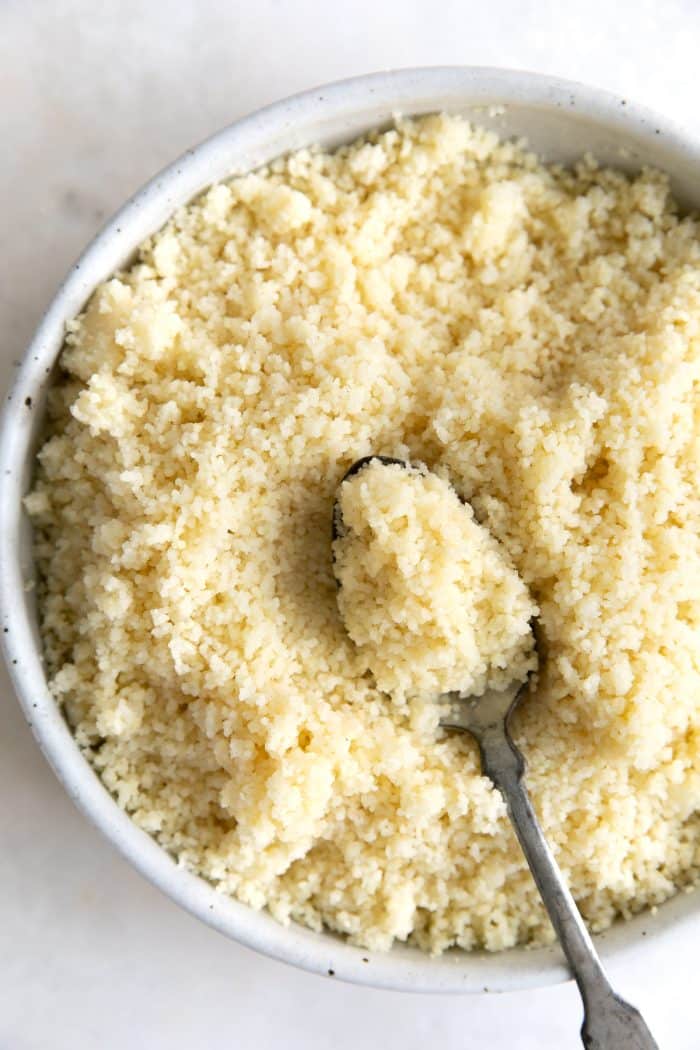
What is Couscous?
Couscous (pronounced “KOOS-koos”) is made of durum wheat and semolina that are moistened and tossed together to form little balls. In the case of couscous, semolina – the coarse purified wheat middlings is made from durum wheat and is pale yellow in color. Couscous is typically made by mixing approximately 2 parts semolina with 1 part durum flour.
- Wheat middlings – product of the wheat milling process that is not flour and typically a good source of protein, fiber, phosphorus, and other nutrients.
If you’re thinking, right, but what does this all mean? Let me try to translate.
Couscous is closely related to pasta, like orzo.
Yes, pasta.
And despite its similarities with quinoa, couscous is made from flour while quinoa is actually a seed. Quinoa is healthier, high in protein and fiber, and naturally gluten-free. Couscous, on the other hand, is made from wheat and is not gluten-free.
Originating in North Africa sometime around the 7th century, couscous still remains a staple food throughout northeast Africa and is traditionally served under a meat or vegetable stew like this easy Moroccan chicken or Moroccan beef Tagine with Eggplant that may be filled with various ingredients including dried fruits, spices, herbs, and nuts. When cooked properly, couscous should be light and fluffy, never gummy or gritty (an indication that your couscous has either been over or undercooked).
Couscous Preparation
Pick up couscous from any western supermarket and you’re probably purchasing Instant couscous. Unlike traditional couscous, this couscous has been conveniently pre-steamed and dried resulting in shorter cooking time.
Traditionally, however, couscous preparation would have been a much more time-intensive project, often requiring several days.
Couscous, as we know, is made from the hard parts of durum wheat that is resistant to the grinding from the millstone. These hard, resistive parts (also known as semolina) are sprinkled with water and rolled with the hands to form small pellets. To keep the pellets separate, they’re dusted with durum flour and then sieved. Those pellets that are too small to be finished couscous granules fall through the sieve where they are rolled again, sprinkled with semolina, and rolled into pellets. This process repeats over and over until all the semolina has been formed into tiny granules of couscous.
Once the couscous is made, it is traditionally cooked (often multiple times) in a food steamer called a taseksut in Berber, a كِسْكَاس kiskas in Arabic, or a couscoussier in French. Bulky, inconvenient, and tricky to master, most people opt for Instant couscous.
How to Cook Couscous
The couscous that I will be talking about in-depth in the remainder of this post is for Instant couscous. Lucky for us, this version only requires a simple pot with a lid and approximately 10-20 minutes to cook, start to finish depending, on the type used.
Speaking of types, there are two types of couscous you’re likely to find sold in your local market: Moroccan couscous and Israeli, also known as pearl couscous. The cooking method for each is quite similar with a few minor differences which I’ll detail below.
Couscous: Frequently Asked Questions
Is couscous gluten-free?
No, couscous is not gluten-free and should be avoided if you are sensitive to gluten or have celiac disease. It is made from wheat and not gluten-free.
Is couscous a carb?
Yes. Couscous is made from wheat and therefore a carbohydrate.
Is couscous pasta?
No, not exactly. Couscous is made from the same type of durum wheat as pasta, however, unlike pasta, it is made from the crushed durum wheat semolina not (only) the ground type that is used to make pasta (although that’s in there too).
Is couscous keto?
No way. If you’re following any kind of low carb diet, couscous is not something you’ll want to include in your weekly dinner rotation.
How long does a box of couscous stay fresh?
Uncooked, packaged and sealed, couscous can stay fresh for up to two years. If you purchase from a bulk bin, be sure to transfer and keep stored in a well-sealed container labeled with the date of purchase.
Is couscous good for you?
Let’s chat a little bit about couscous nutrition.
I mean, is couscous even good for you?
Nutritional information for 1/3 cup dry (62 g) Moroccan couscous:
Calories: 230
Fat: 0g
Saturated Fat: 0g
Unsaturated Fats: 0g
Carbohydrate: 48g
Sodium: 5mg
Fiber: 3g
Protein: 8g
Sugar: 1g
Source:bobsredmill
Nutritional information for 1/3 cup (57g) uncooked Israeli couscous:
Note- it is not specified if the nutrition facts are for cooked or dry couscous – I’m guessing that it is for dry.
Calories: 310
Fat: 1g
Saturated Fat: 0g
Unsaturated Fats: 0g
Carbohydrate: 80g
Sodium: 5mg
Fiber: 2g
Protein: 6g
Sugar: 1g
Source: bobsredmill
Couscous is a fun and delicious alternative to regular pasta and pairs perfectly with salads, soups, and stews. Unfortunately, it doesn’t offer the same nutritional benefits as whole grains such as barley, bulgur, or brown rice. It is not gluten-free, loaded with protein or fiber, and does not come filled with loads of surprise vitamins and nutrients. If high fiber, protein-rich foods are an important part of your diet, I highly recommend choosing whole-wheat couscous. Same delicious taste with double the fiber.
Types of Couscous
There are two main types of couscous: Moroccan couscous and Israeli (Pearl) couscous.
Moroccan Couscous – The smallest type, but most likely to be found in grocery stores. The instant version of Moroccan couscous cooks in approximately 5-10 minutes. Some supermarkets may also sell whole wheat versions which are healthier than the alternative.
Israeli (Pearl) Couscous – Approximately the size of a peppercorn, it’s size is the most noticeable difference when compared to Moroccan couscous. Also available in whole wheat varieties, Israeli couscous has a slightly chewy texture and requires a slightly longer cooking time. It is often toasted in butter or olive oil before boiling which lends a wonderful nutty flavor to the dish.
Moroccan Couscous
- Total cook time – approximately 5 minutes
- 1 cup dried yields approximately 2.5 cups cooked
- Uses – As a side, added to burgers, tossed with salads, soups, or stew.
Moroccan Couscous Recipes:
Couscous Salad with Cilantro Orange Vinaigrette
Orange Pistachio Pomegranate Couscous Salad, via Recipes From A Pantry
Moroccan Couscous Salad, via Cooking For My Soul
How to Cook Moroccan Couscous
Instant Moroccan Couscous on the Stovetop
-
Bring the water (or broth), olive oil, butter, and salt to a boil in a medium saucepan set over high heat.
-
Add the couscous and stir well. Remove from heat and cover with a tight-fitting lid.
-
Allow the couscous to stand, undisturbed, for approximately 5 minutes or so, or until the water had been absorbed and the couscous is tender. Use a fork to fluff the couscous and break up any large clumps that may have forked.
Instant Moroccan Couscous in the Microwave
-
Transfer the water (or broth) to a large microwave-safe glass or bowl. Microwave until boiling, approximately 4-5 minutes.
-
Sir in the olive oil, butter, and salt. Mix well to combine. Add the couscous, stir, and cover with foil or plastic wrap
-
Allow the couscous to stand, undisturbed, for approximately 5 minutes or so, or until the water had been absorbed and the couscous is tender. Use a fork to fluff and break up any large clumps that may have forked.
Can you freeze couscous?
Yes. To freeze, first allow your couscous to cool completely before transferring to a freezer-friendly bag. Remove as much air as possible and transfer to the freezer. Best if enjoyed within 3 months.
Note – I do not recommend freezing Israeli couscous.
Israeli Couscous
- Total cook time – approximately 10-15 minutes
- 1 cup dried yields approximately 2 cups cooked
- Uses – As a side, tossed with salads, soups, or stew.
Recipes:
- Middle Eastern Curried Lamb Meatballs with Couscous
- Spinach Pesto with Couscous and Shrimp, via My Kitchen Love
- Lemon Cucumber Couscous Salad, via 4 Sons ‘R’ Us
- Israeli Couscous with Asparagus, Peas, and Sugar Snap Peas, via Belly Full
How to Cook Israeli Couscous
Israeli couscous is similar in taste, texture, and cooking method to that of pasta. Toasting in olive oil or butter before boiling is optional, but highly recommended and just like pasta, cook just until al dente to prevent it from overcooking.
-
(Optional) Toast your couscous first – Add the butter and olive oil to a medium saucepan set over medium-high heat. Add the couscous and stir to coat in the butter and olive oil. Stirring continuously to prevent burning, toast your couscous for 2-3 minutes, reducing heat to medium or medium-low if necessary.
-
Remove the toasted couscous to a clean plate.
-
Add the water (or broth) and salt to the saucepan and bring to a boil. Stir in the toasted couscous and return to a boil.
-
Immediately reduce heat to low, cover, and continue to cook until tender, approximately 15 minutes. Gently fluff with a fork.

More Middle Eastern Recipes,
- How to Make Harissa Paste
- Muhammara Recipe (Red Pepper and Walnut Dip)
- How to Make Pomegranate Molasses
- Baba Ganoush Recipe (How to Make Baba Ganoush)
- Tabbouleh (Tabouli Salad Recipe)
If you try making Couscous, please leave me a comment and let me know! I always love to hear your thoughts.
RECIPE CARD
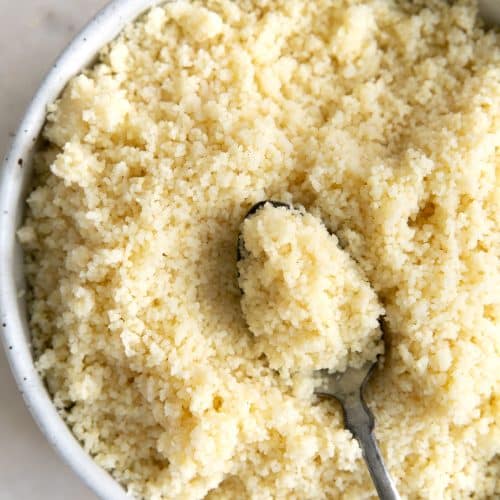
How to Cook Couscous
Ingredients
Moroccan Couscous (Stovetop & Microwave)
- 1 ¾ cups water - or broth
- 1 tablespoon olive oil
- 1 tablespoon butter
- ½ teaspoon salt
- 1 ½ cups Moroccan couscous
Israeli (Pearl) Couscous (Stovetop only)
- 1 tablespoon olive oil
- 1 tablespoon butter
- 1 ½ cups Israeli couscous
- 2 cups water - or broth
- ½ teaspoon salt
Instructions
Moroccan (instant) Couscous - Stovetop
- Bring the water (or broth), olive oil, butter, and salt to a boil in a medium saucepan set over high heat.
- Add the couscous and stir well. Remove from heat and cover with a tight-fitting lid.
- Allow the couscous to stand, undisturbed, for approximately 5 minutes or so, or until the water had been absorbed and the couscous is tender. Use a fork to fluff the cooked couscous and break up any large clumps that may have formed.
- To freeze: Allow the couscous to cool completely before transferring to a freezer-friendly bag. Remove as much air as possible and transfer to the freezer. Best if enjoyed within 3 months.
Moroccan (instant) Couscous - Microwave
- Transfer the water (or broth) to a large microwave-safe glass or bowl. Microwave until boiling, approximately 4-5 minutes.
- Sir in the olive oil, butter, and salt. Mix well to combine. Add the couscous, stir, and cover with foil or plastic wrap
- Allow the couscous to stand, undisturbed, for approximately 5 minutes or so, or until the water had been absorbed and the couscous is tender. Use a fork to fluff the cooked couscous and break up any large clumps that may have formed.
- To freeze: Allow the couscous to cool completely before transferring to a freezer-friendly bag. Remove as much air as possible and transfer to the freezer. Best if enjoyed within 3 months.
Israeli (Pearl) Couscous (Stovetop only)
- Add the butter and olive oil to a medium saucepan set over medium-high heat. Once the butter has melted stir in the couscous and stir to coat in the butter and olive oil. Stirring continuously to prevent burning, toast your couscous for 2-3 minutes, reducing heat to medium or medium-low if necessary.
- Remove the toasted couscous to a clean plate.
- Add the water (or broth) and salt to the saucepan and bring to a boil. Stir in the toasted couscous and return to a boil.
- Immediately reduce heat to low, cover, and continue to cook until tender, approximately 15 minutes. Gently fluff with a fork.
- Note -If your couscous is cooked and tender but all the water hasn't been absorbed, simply fluff your couscous with a fork and carefully drain any remaining water that may remain.
Jessica's Notes
Nutritional Information
(Nutrition information provided is an estimate and will vary based on cooking methods and specific brands of ingredients used.)
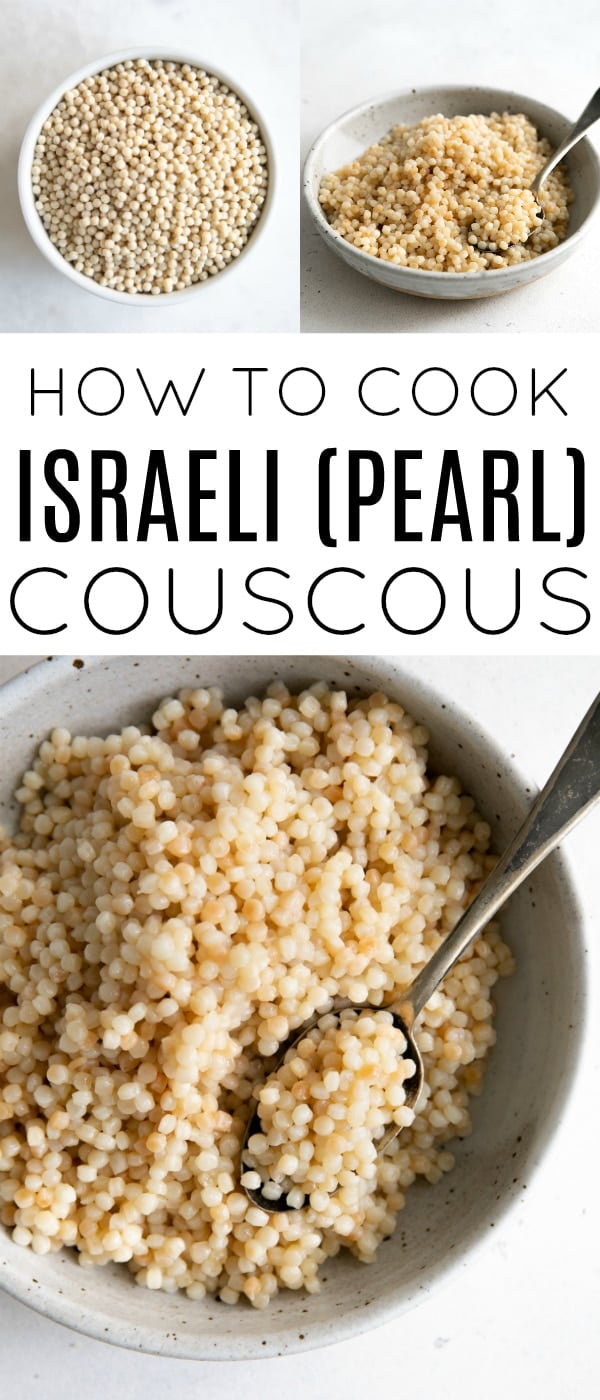
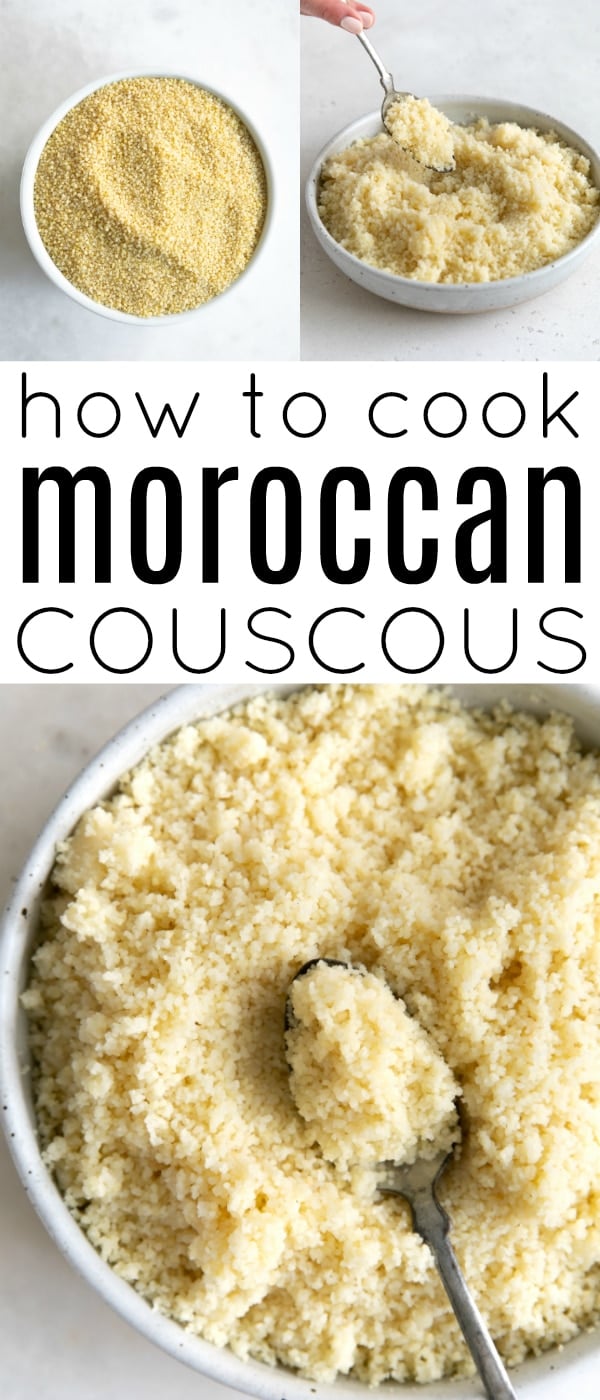

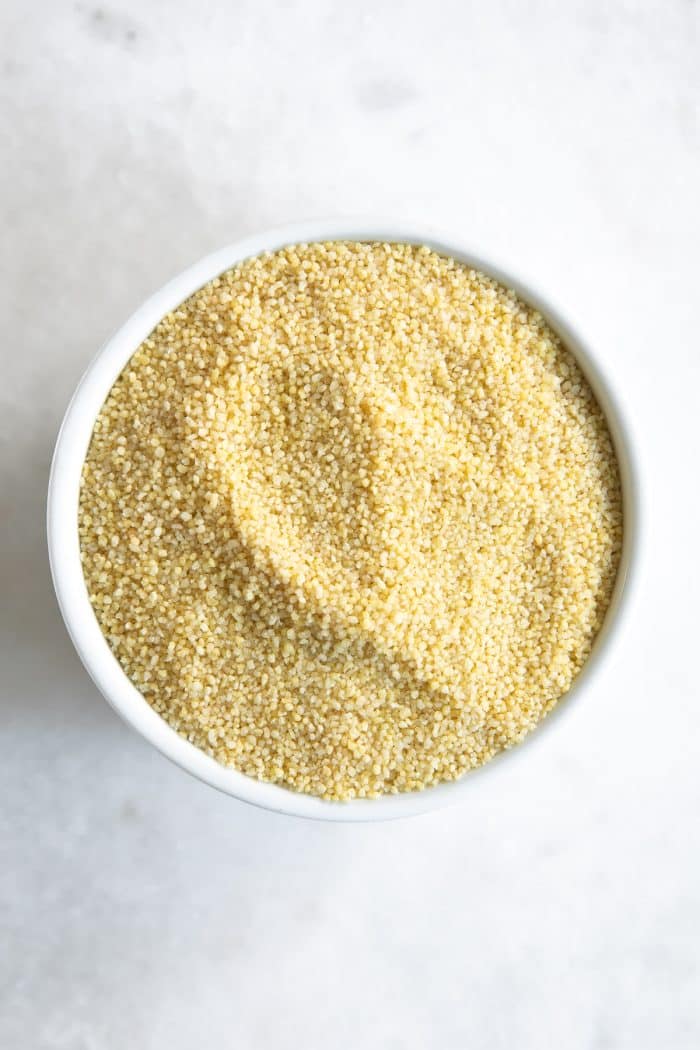
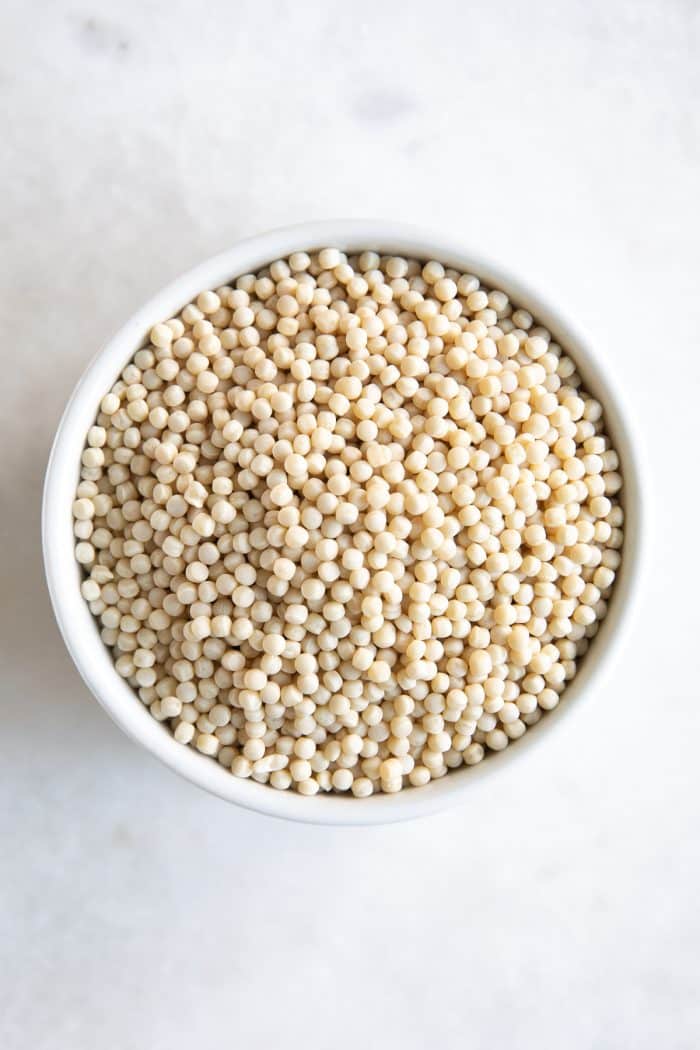
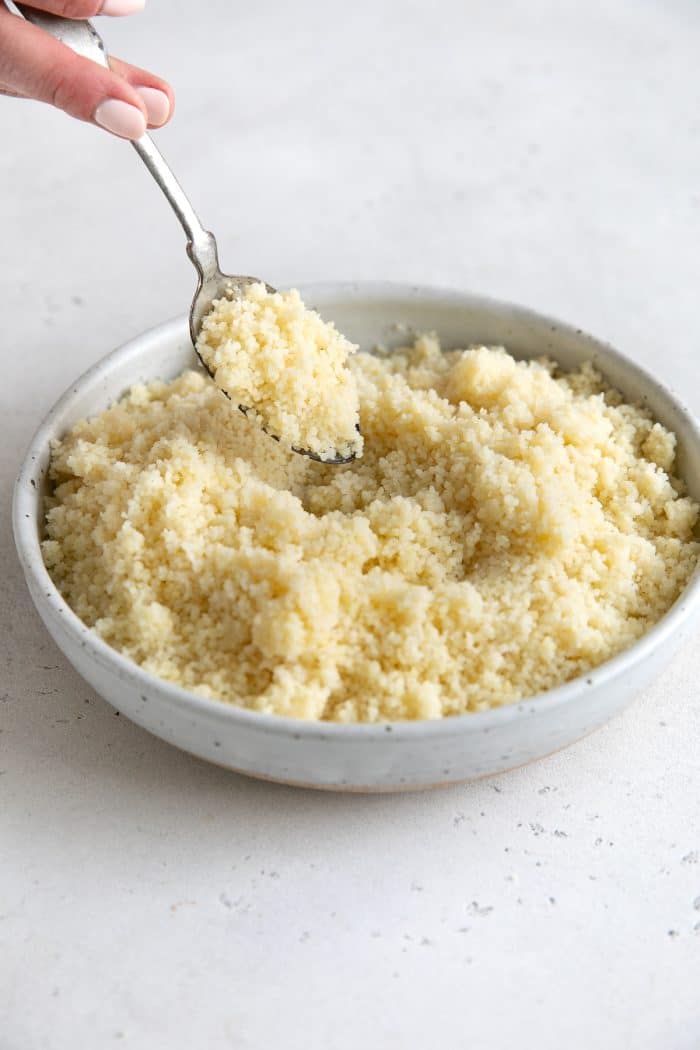


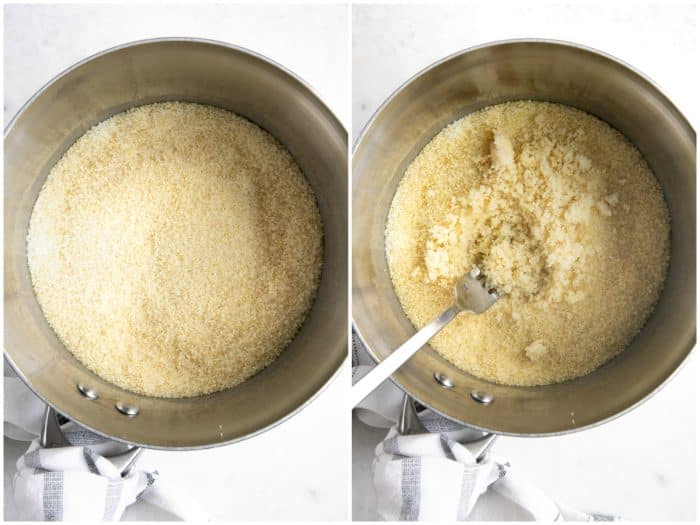
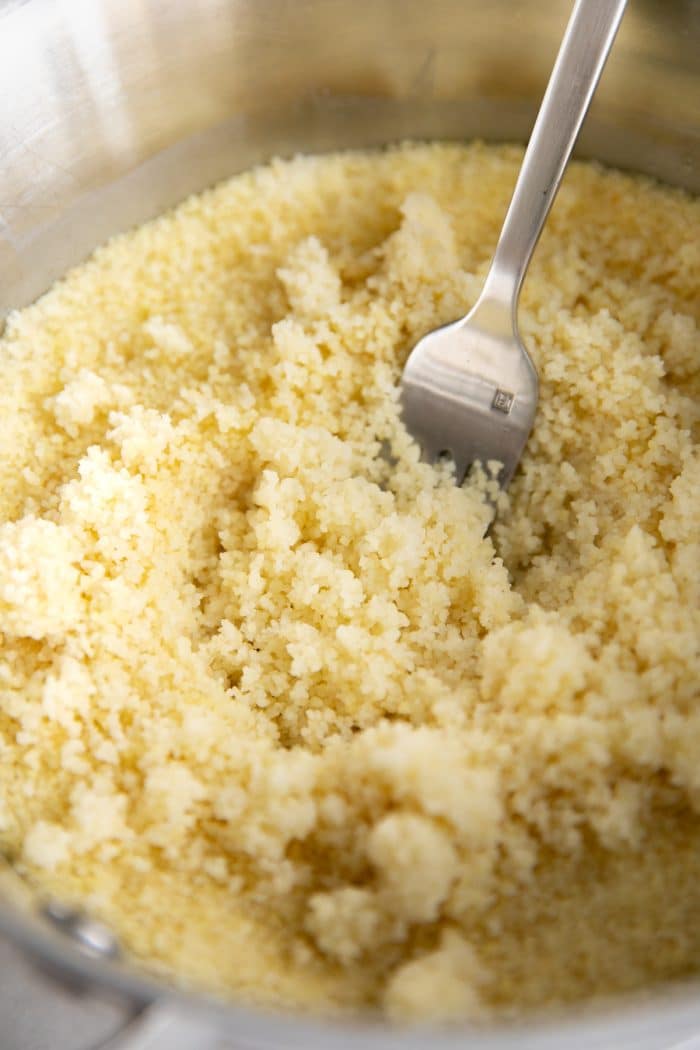





Nice recipe, but best way for cooking the Moroccan couscous is by using the steam cause by some boiling water. Yes this can take quite some time but the result is much more better than just tossing this thing into water. Honestly first time I’ve seen people boil their couscous got me in shock. It was a new way of perceiving life. I thought they were doing it wrong, but it’s just another way of cooking it. It’s not the traditional way like I was taught at home but at least it could be a good meal for some people in a hurry. Anyways it was a nice presentation you did there of both kind of couscous. Also the Moroccan couscous can be offered in a wide range of grain size (of course, they do not get as big as the Pearl couscous) and also different cereals or even whole grain couscous.
Thank you for the feedback Ahmed 😀